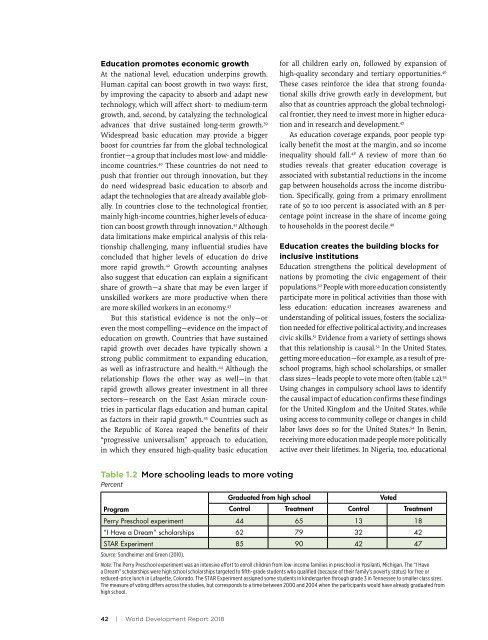Brasil só deve dominar Leitura em 260 anos, aponta estudo do Banco Mundial Relatorio Banco Mundial _Learning
Create successful ePaper yourself
Turn your PDF publications into a flip-book with our unique Google optimized e-Paper software.
Education promotes economic growth<br />
At the national level, education underpins growth.<br />
Human capital can boost growth in two ways: first,<br />
by improving the capacity to absorb and adapt new<br />
technology, which will affect short- to medium-term<br />
growth, and, second, by catalyzing the technological<br />
advances that drive sustained long-term growth. 39<br />
Widespread basic education may provide a bigger<br />
boost for countries far from the global technological<br />
frontier—a group that includes most low- and middleincome<br />
countries. 40 These countries <strong>do</strong> not need to<br />
push that frontier out through innovation, but they<br />
<strong>do</strong> need widespread basic education to absorb and<br />
adapt the technologies that are already available globally.<br />
In countries close to the technological frontier,<br />
mainly high-income countries, higher levels of education<br />
can boost growth through innovation. 41 Although<br />
data limitations make <strong>em</strong>pirical analysis of this relationship<br />
challenging, many influential studies have<br />
concluded that higher levels of education <strong>do</strong> drive<br />
more rapid growth. 42 Growth accounting analyses<br />
also suggest that education can explain a significant<br />
share of growth—a share that may be even larger if<br />
unskilled workers are more productive when there<br />
are more skilled workers in an economy. 43<br />
But this statistical evidence is not the only—or<br />
even the most compelling—evidence on the impact of<br />
education on growth. Countries that have sustained<br />
rapid growth over decades have typically shown a<br />
strong public commitment to expanding education,<br />
as well as infrastructure and health. 44 Although the<br />
relationship flows the other way as well—in that<br />
rapid growth allows greater investment in all three<br />
sectors—research on the East Asian miracle countries<br />
in particular flags education and human capital<br />
as factors in their rapid growth. 45 Countries such as<br />
the Republic of Korea reaped the benefits of their<br />
“progressive universalism” approach to education,<br />
in which they ensured high-quality basic education<br />
for all children early on, followed by expansion of<br />
high-quality secondary and tertiary opportunities. 46<br />
These cases reinforce the idea that strong foundational<br />
skills drive growth early in <strong>deve</strong>lopment, but<br />
also that as countries approach the global technological<br />
frontier, they need to invest more in higher education<br />
and in research and <strong>deve</strong>lopment. 47<br />
As education coverage expands, poor people typically<br />
benefit the most at the margin, and so income<br />
inequality should fall. 48 A review of more than 60<br />
studies reveals that greater education coverage is<br />
associated with substantial reductions in the income<br />
gap between households across the income distribution.<br />
Specifically, going from a primary enrollment<br />
rate of 50 to 100 percent is associated with an 8 percentage<br />
point increase in the share of income going<br />
to households in the poorest decile. 49<br />
Education creates the building blocks for<br />
inclusive institutions<br />
Education strengthens the political <strong>deve</strong>lopment of<br />
nations by promoting the civic engag<strong>em</strong>ent of their<br />
populations. 50 People with more education consistently<br />
participate more in political activities than those with<br />
less education: education increases awareness and<br />
understanding of political issues, fosters the socialization<br />
needed for effective political activity, and increases<br />
civic skills. 51 Evidence from a variety of settings shows<br />
that this relationship is causal. 52 In the United States,<br />
getting more education—for example, as a result of preschool<br />
programs, high school scholarships, or smaller<br />
class sizes—leads people to vote more often (table 1.2). 53<br />
Using changes in compulsory school laws to identify<br />
the causal impact of education confirms these findings<br />
for the United King<strong>do</strong>m and the United States, while<br />
using access to community college or changes in child<br />
labor laws <strong>do</strong>es so for the United States. 54 In Benin,<br />
receiving more education made people more politically<br />
active over their lifetimes. In Nigeria, too, educational<br />
Table 1.2 More schooling leads to more voting<br />
Percent<br />
Graduated from high school<br />
Voted<br />
Program Control Treatment Control Treatment<br />
Perry Preschool experiment 44 65 13 18<br />
“I Have a Dream” scholarships 62 79 32 42<br />
STAR Experiment 85 90 42 47<br />
Source: Sondheimer and Green (2010).<br />
Note: The Perry Preschool experiment was an intensive effort to enroll children from low-income families in preschool in Ypsilanti, Michigan. The “I Have<br />
a Dream” scholarships were high school scholarships targeted to fifth-grade students who qualified (because of their family’s poverty status) for free or<br />
reduced-price lunch in Lafayette, Colora<strong>do</strong>. The STAR Experiment assigned some students in kindergarten through grade 3 in Tennessee to smaller class sizes.<br />
The measure of voting differs across the studies, but corresponds to a time between 2000 and 2004 when the participants would have already graduated from<br />
high school.<br />
42 | World Development Report 2018








